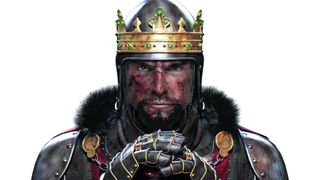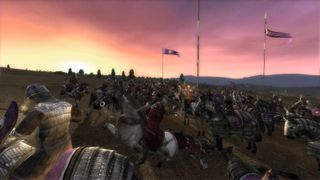Breaking history in Total War: Medieval 2

In Now Playing PC Gamer writers talk about the game currently dominating their spare time. Today, Matt tries to rewrite history in Medieval 2.
Stories in Total War appear without warning, like aunts on damp Sunday afternoons. Attila and Rome 2 deliberately construct these stories, letting you make decisions that nudge the narrative in whichever direction you choose, but I prefer the accidental drama of Medieval 2.
I’m drawn back to Medieval 2: Kingdoms after reading about the Crusades: a compelling period of history, rich in tales of dashing Norman princes, religious fervour and the taut diplomacy of the Byzantine Empire. Specifically, the battle of Manzikert, in which the once-supreme imperial army was crushed by the Turks. It makes me sad, because the Byzantines were always my favourite faction, which is a bit like picking the least-worst racist in an inner-city chain pub, but also: I don’t care. Compared to the frothing barbarians of the West, Constantinople had guile and romance. I decide to make myself feel better by changing history, because games let me do that.
I start a new Crusades campaign, 100 years after Manzikert. My empire is diminished but capable—although huge chunks of Anatolia belong to the Turks, it’s still possible to fight back. Soon, purple fingers begin stretching across the map, gradually reclaiming lost lands which were probably taken from someone else in the first place. I construct mines and grow crops. I send emissaries into enemy lands to spread religious dissent. On the faction rankings graph, my purple line creeps upwards while Turkish forces diminish.

I reach that moment that comes in every Total War game, where armies fight to determine the future of each faction. It’s an event where the lines on the graph converge; one faction falls, another ascends. Our forces clash at Amorium, and it’s butchery. My general is killed, and the future of my campaign is left dangling from thin gristle like a hacked arm. A wave of green threatens to wash my forces away, leaving the path to Constantinople unguarded Unexpectedly, a young Byzantine warrior steps forward. Instead of fleeing, my troops rally to him. He charges the vulnerable flanks of the Turkish army, presumably screaming something really inspirational, and one by one, the enemy forces rout. Being a true hero, he hacks them down as they flee.
The Doge is captured, I ransom him for 28,000 gold, capture him again, then execute him.
Brilliantly, my hero’s name is Modestos Bringas. I reinforce his army and send him after the remnants of the shattered Turkish forces. He pursues them relentlessly, menacing the fringes of the Seljuk empire for years, and I almost forget about him. Back in the West, a Venetian crusader force appears, intent on reclaiming Jerusalem. They’re dangerously close to my capital, but being fellow Christians, they’ll definitely pass by harmlessly.
The Venetians take Constantinople. Only one person is near enough to save the city: Modestos. I march him back to the capital. The Venetian force is led by the Doge. (That’s their leader, not the smug dog.) Modestos pushes forward to Constantinople, marches through the same holes the crusaders made in my city walls, and expels them. The Doge is captured, I ransom him for 28,000 gold, capture him again, then execute him. Modestos Bringas, once nothing more a humble soldier, has saved the greatest city in Christendom. If only he’d been at the battle of Manzikert.
The biggest gaming news, reviews and hardware deals
Keep up to date with the most important stories and the best deals, as picked by the PC Gamer team.

If you love big trucks, establishing trade routes, and the phrase 'post-apocalyptic survival business simulator' then I've got just the strategy RPG for you

Blizzard veteran David Kim's strategy comeback with Battle Aces is 'very personal:' 'I just can't accept... the end-all peak of RTS is StarCraft 2 and nothing can ever be better'
Most Popular

